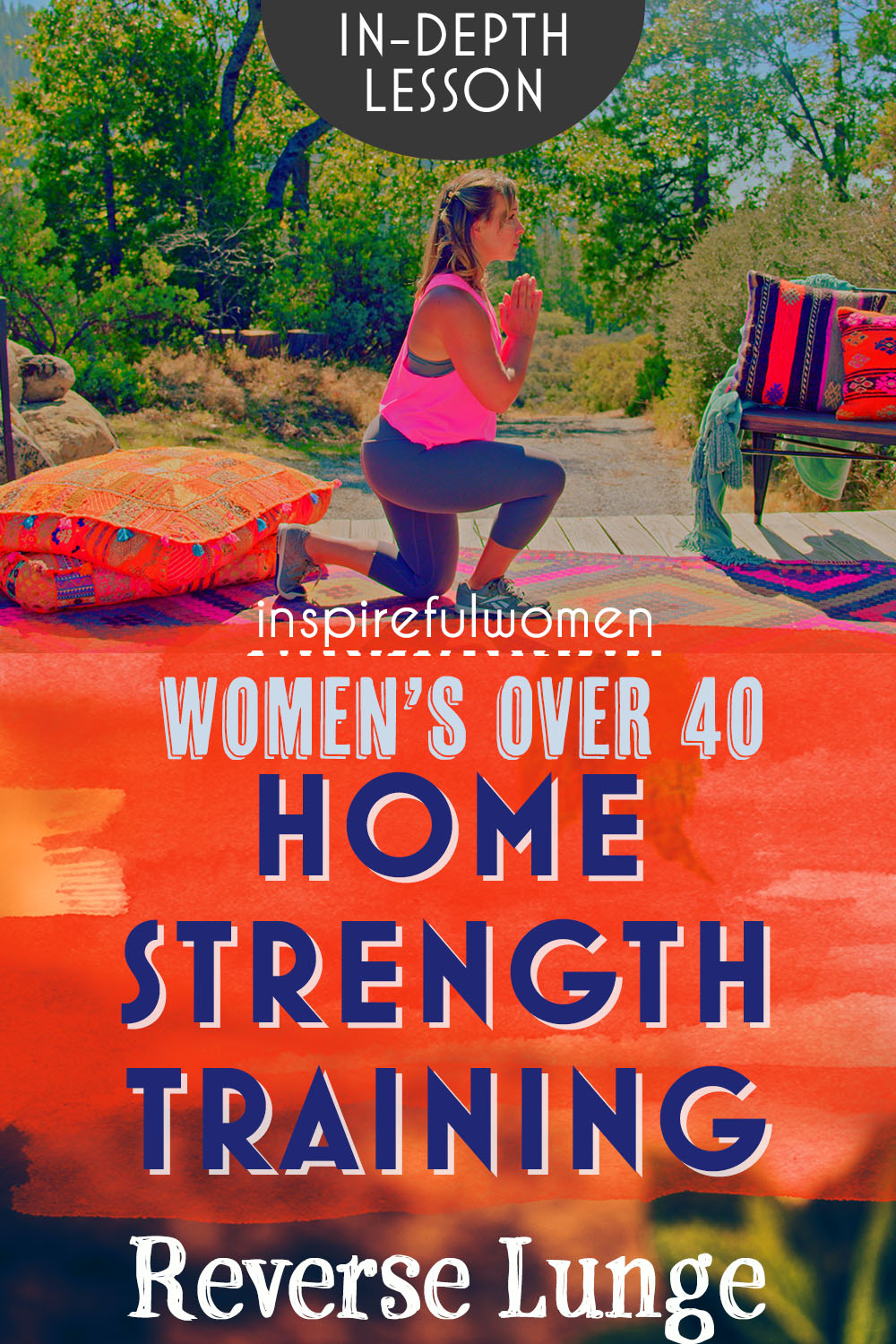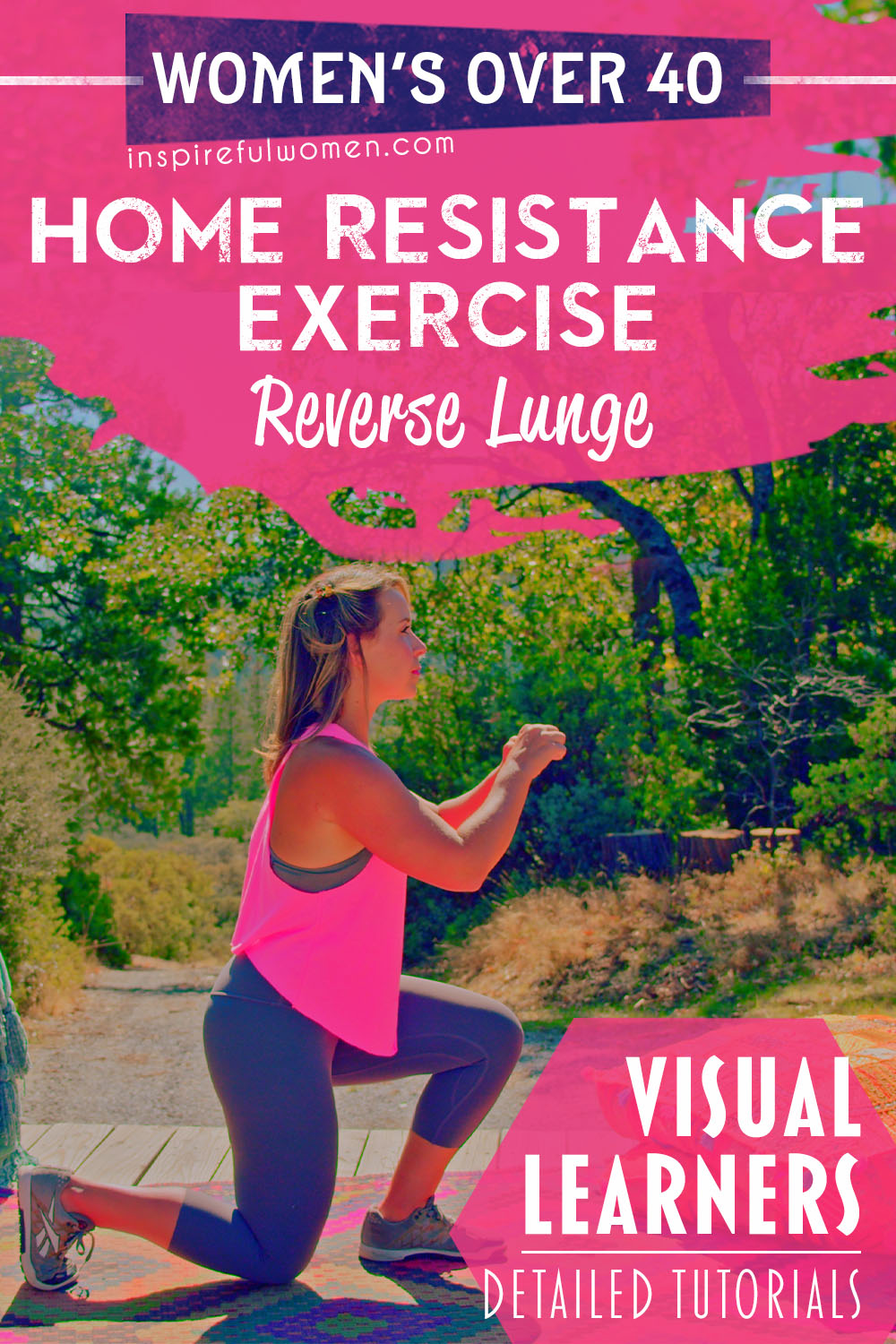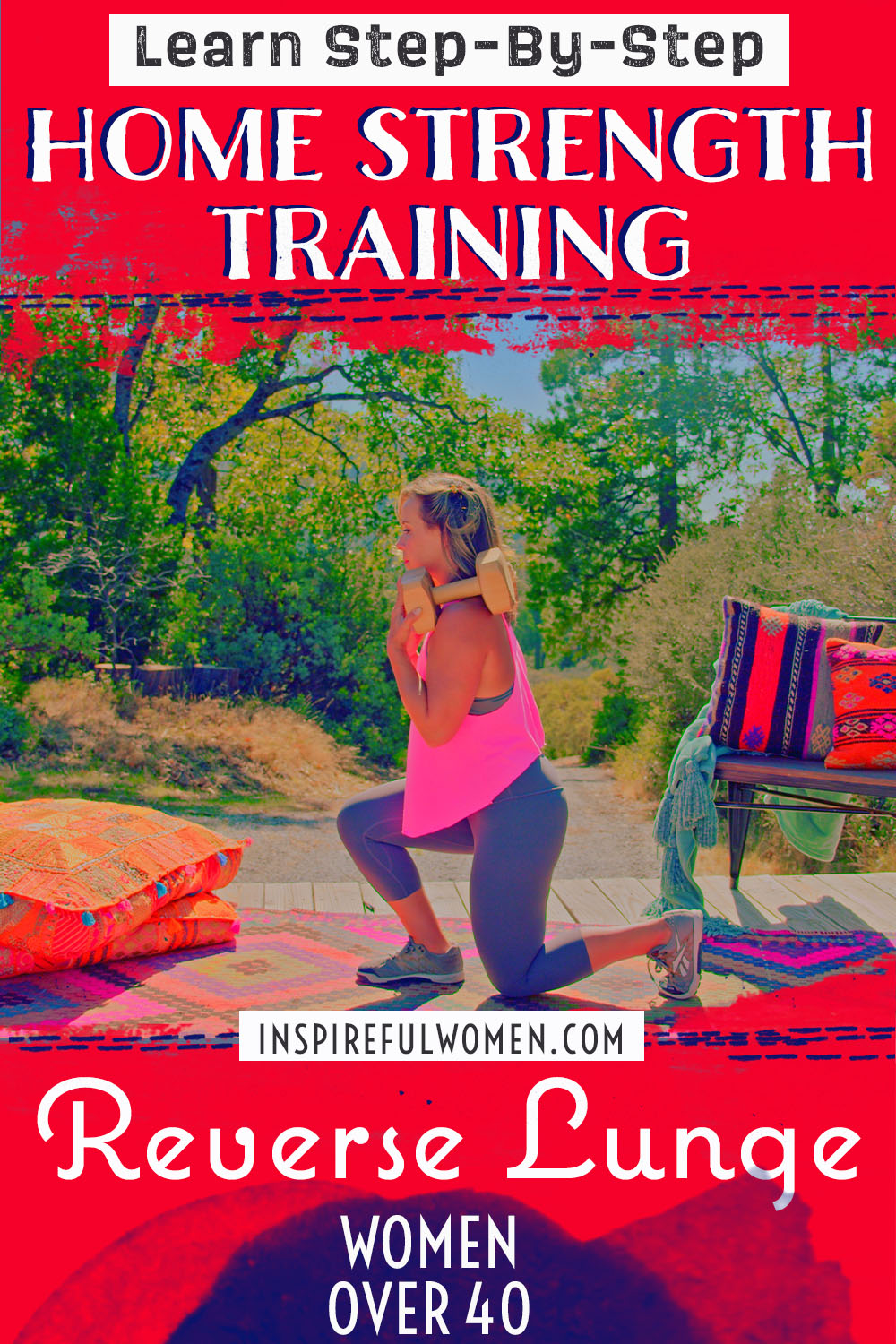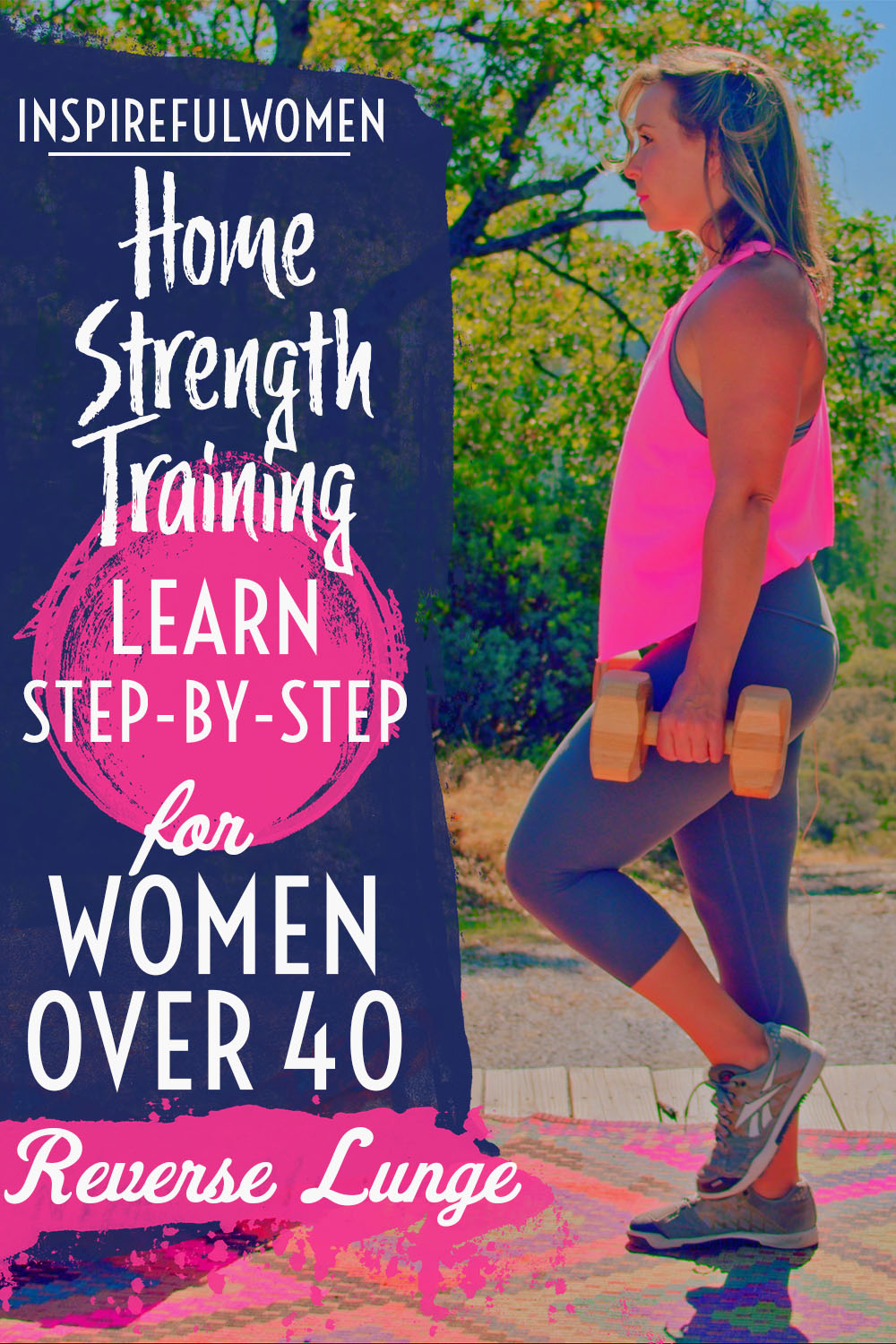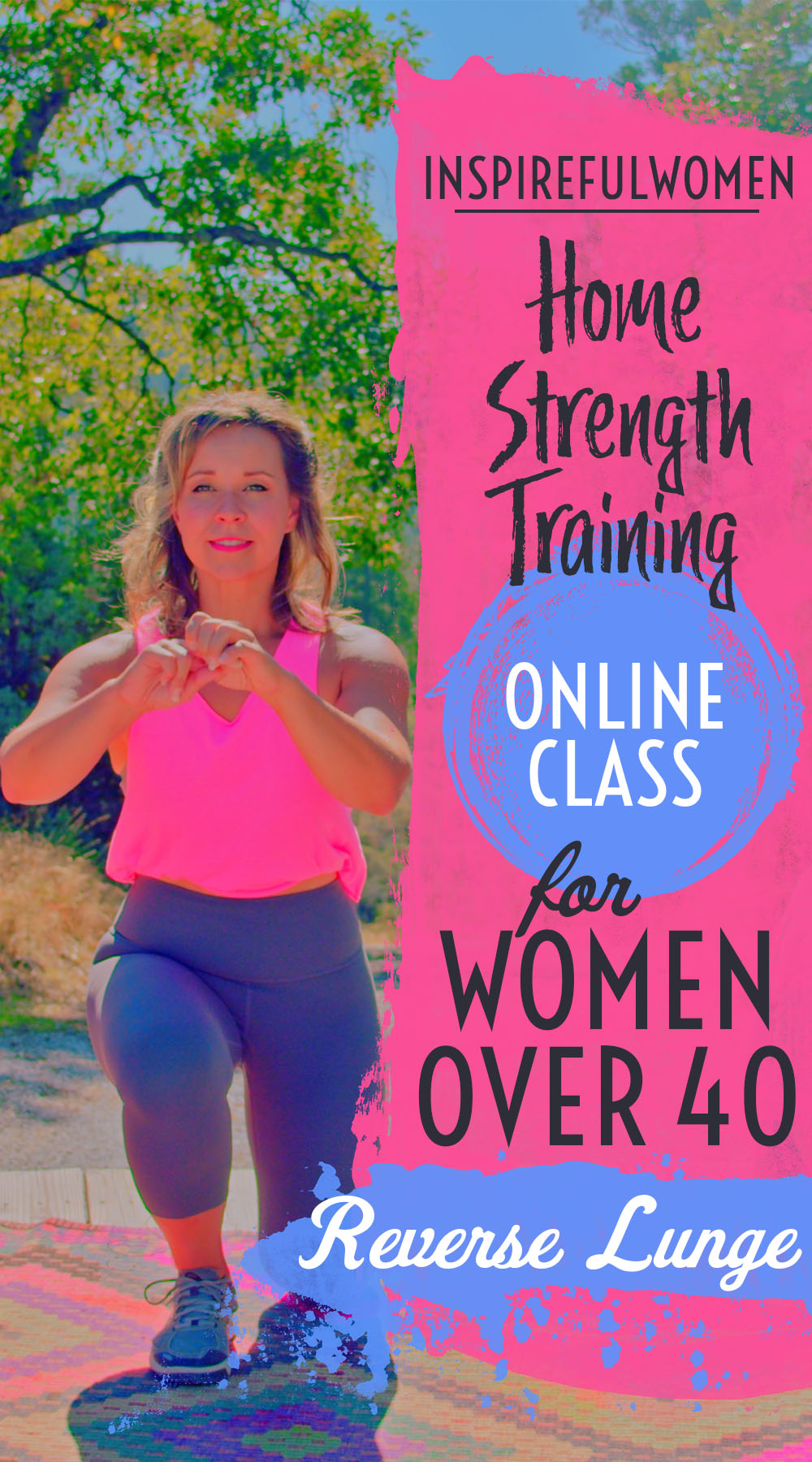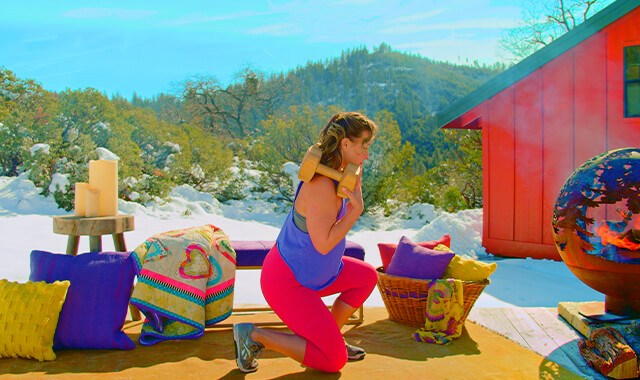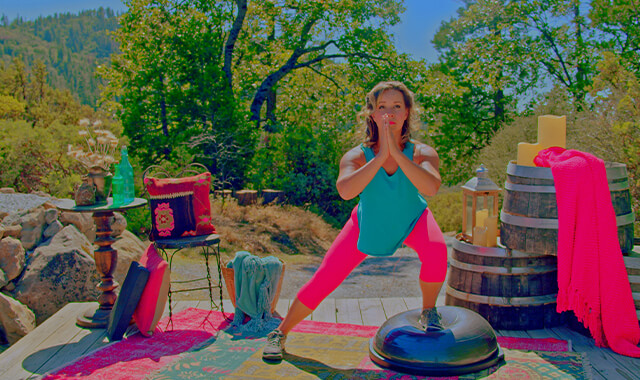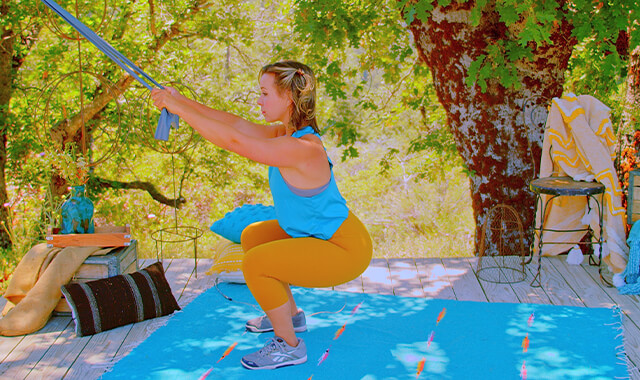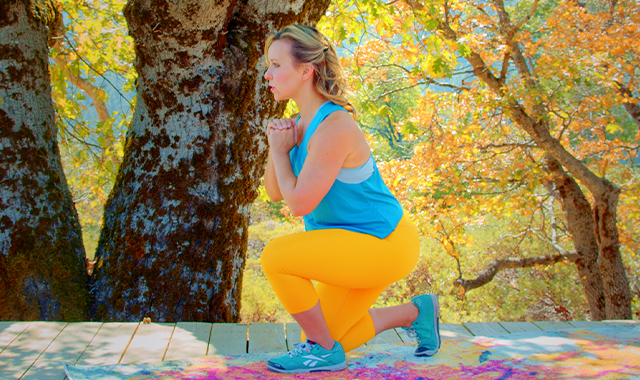Reverse Lunge
How to Do the Reverse Lunge - Squat Alternative for Bad Knees - Quad-Focused Exercise | In-Depth Guide [VISUAL LEARNERS] Beginner
Proper Form, Common Mistakes, Easier, & Harder Variations | Home Strength Training
WHAT DO YOU WANT TO SEE?
QUICK DEMO
QUICK DEMO
MUSCLES THIS WORKS
MUSCLES
MAIN MUSCLES WORKED IN the Reverse Lunge
Quadriceps, Gluteus Maximus, & Hamstrings
OTHER MUSCLES WORKED:
- Gluteus Medius and Minimus
WHAT WE'RE DOING TODAY
WHAT & WHY
BENEFITS OF TRAINING THE Quads, Glutes, & Hamstrings
WHAT
WHAT WE'RE DOING TODAY
Other names for this exercise: Backward Lunge, Back Lunge
I feel like any sane person hates lunges. So if you hate lunges, guess what? That PROVES you are mentally stable - I fit into that category so I can just ignore whatever my family tries to tell me about that. ;)-
Because I’m sane, I don’t program hundreds of lunges in the Inspireful Women workout program. That said, lunges DO have a place in pursuing fitness which we’ll talk about in the why section soon. But for now, let me say this. Of all the types of lunges you can do, you’re going to hate reverse lunges the LEAST.
This means these are the best lunges to start with - maybe even stick with - forever.
That’s because the working legs stay in place, unlike other lunges - thus it’s much easier to do these with proper form, AND it also means our glutes & hamstrings are more involved with the quads than other types of lunges - so you have three big muscles helping you stand back up instead of just mostly the quads as in other types of lunges. I don’t know about you but I need all the help I can get to get myself back up off the floor - with any element of grace at least.
And remember, lunges are a single-leg exercise - this means your working leg is lifting nearly all of your body weight, minus the weight of your lower legs. So example - if you weigh 175 lbs, your working legs are lifting somewhere in the neighborhood of 150 lbs all by its lonesome! If you think of it like this, that sort of gives away one of the “why” reasons for including lunges some of the time, in reasonable doses, in a workout program. Because you can build real strength & muscle, at home, pretty easily with just your body & at some point a couple of light dumbbells. Our leg muscles are BIG, STRONG, and there’s more than one - for double leg exercises like squats & deadlifts, you have to use a LOT of weight to actually challenge these muscles sufficiently to build real muscle- and we typically don’t have those sorts of heavy weights at home to work with and even if we did, many women feel uncomfortable using them. By doing exercises with one leg, you instantly increase the load that leg is working with substantially, & you don’t need all those weight machines & heavy weights to build leg muscle, & thus you can avoid the stinky gym. You’re welcome.
—————-
Reverse lunges are a nice addition to any lower-body workout. The exercise works many of the muscles of the legs and moves the ankle, knee, and hip joints through a large range of movement. Reverse lunges target the biggest muscle groups of the legs and have the added bonus of working on stability, balance, control, and core strength. Another plus is that reverse lunges work the same muscles as the forward lunge but can be easier on the knees, making it a good choice if you have problems with your knees. The reverse lunge will also work the muscles on the back of the hip and leg more (gluteus maximus and hamstrings).
In the reverse lunge, the lunging leg (front leg) stays in place as the hip and knee bend down to lunge and then push back up. This makes it much easier to use the gluteus maximus and hamstrings to straighten the hip at the top of the movement - when you are returning to standing after the downward lunge. This is different from the forward lunge. In the forward lunge, the front leg has to step backward after it lunges. In order to step backward the knee and hip are slightly flexed, which results in less gluteus maximus and hamstring contribution (because the hip is not loaded when it moves to neutral) – the quadriceps do most of the work.
The reverse lunge should feel controlled. The working leg stays under your torso as the other leg steps back. So you can slow down and feel control during each part of the movement. There is so much going on with a reverse lunge, if you pay attention to what you are feeling and which parts of it are challenging - you can really learn a lot about your strengths and weaknesses. You can use this information as a mini self-assessment. Your discoveries will tell you something about what you need to work on, you may need to work on your balance, core stability, ankle or toe range of motion, muscle tightness, etc. You will know if you are on the right track if the quality of the movement improves and the exercise gets easier over time. For example - When you first pick your leg up to step back into the lunge - how is your balance? How stable is your leg? Does your pelvis drop down? When you place your foot back, do you feel a stretch, and if so, where? As you lunge down, do you lose your balance? Is it challenging to keep your balance or to keep your trunk upright? Does your front leg start to shake? Or do you feel like the movement is limited by your ankle, knee, or hip?
WHY BOTHER DOING IT?
WHY
WHY DO WE EVEN CARE?
#1 For reals build muscle & strength in your legs at home.
This is a mostly single-leg exercise - this means that one leg will be lifting the majority of your body weight all by itself. Which is pretty stinking hard. When something is stinking hard for your muscles, guess what, they react by getting stronger.
Because our leg muscles are already big & strong by design & there are multiple ones - quads, hamstrings, glutes, calves - when they work together to do something, they just naturally can handle a pretty heavy load - compared to say, our much smaller shoulder muscle. This means that to truly challenge all these leg muscles together - enough to the point where doing 8-12 reps of something is really all they can stretch themselves to do, in order for them to respond by building muscle, we have to have QUITE a bit of load.
In double leg exercises like squats &deadlifts, this usually means that you have to use very heavy weights- often with the use of machines or super big dumbbells or barbells with plates - which then typically means a trip to the gym for most of us. But who wants that? We’re about working out at HOME here at Inspireful Women - in a non-intimidating environment, with your cat or dog revering you by your side as you exercise, the wonderful non-gym smell of your living room, the visually pleasing environment of your personal taste in decor whether that be mid-century modern, boho or industrial farmhouse (btw I feel like my style is more like industrial bohemian, & I thought I made that term up until I looked it up on pinterest & it’s already a thing). Single-leg exercises are an effective way to stay out of the gym while still building real muscle in our legs.
#2 Functional - trains multiple muscles to work together just like they do in real life.
Lunges are known as compound (also referred to as complex or combined) movements - the movement requires the coordination of many muscles and joints. These exercises are considered more functional because they work the muscles and joints together in similar ways to how we use them in everyday life. Most of our daily activities involve movement at more than one joint at a time, and a combination of strength, flexibility, joint mobility, balance, and stability.
The reverse lunge is used for strengthening the biggest and most powerful muscles in the hip and leg. The movement works the quadriceps, gluteus maximus, hamstrings, and calf muscles both as you lunge down (eccentrically) and as you press back up (concentrically) to encourage muscle growth and improve power. With stronger and more powerful legs, the back does not have to work as hard - the legs do more of the heavy lifting and moving. The reverse lunge also targets the core and leg stabilizers needed for balance during sports and daily activity and to protect the joints of the spine and lower extremities.
#3 Large ROM for Our Biggest Muscles = Keeps You Young - May Even Make You YOUNGER!
Lunges are taking our bodies through a lot of range of motion through lots of joints - this is EXCELLENT for us because as we get older & move less often, stop doing things like spontaneously running or jumping the way kids do- isn’t it so peculiar that kids do that? Anyhow, we quit all that nonsense + just AGING (definition our body naturally falls apart over time) = our joints gradually become stiffer & less able to fluidly move through their full range.
The reason this is a problem is because many movements in life require using those joints through their full range to do properly, capably, & without pain.
An exercise like this will get a ton of these joints moving all in one exercise, rather than having to do a separate exercise for each joint - all the way down to our ankles & toe joints! Over time, you will find that you simply feel more capable as you go about moving in everyday life. I know I’ve really noticed a difference.
#4 Reverse Lunge = Less Knee Strain
For many of us, we might be using the excuse that lunges hurt our knees and THAT’S why we don’t do them (when really we just hate lunges because they’re stinkin’ hard, which I’m here to tell you is a totally legit reason all in itself).
Really though, it’s true, lunges can present a problem for some of our over 40 knees. My knees are like “Hey woman, I’m over 40 years old now. That’s my get-out-of-lunges-free card, so back off.”
The first thing I want to say is that if you have knee pain in some exercises- there is a way to build up the muscles & stabilizing muscles that surround your knee joint, which can eventually make even those movements pain-free for you. That’s for another discussion.
But back to reverse lunges - this particular type of lunge puts less strain on the front of the knee than a forward lunge because the front leg stays in a balanced and stable position while the body weight is loaded onto the working leg (as the other leg steps backward).
Contrast that to the front lunge, where the working leg steps forward and as it makes contact with the ground - in this case the quadriceps muscle has to work to absorb the impact while slowing down the forward movement of the weight of the body. This can put more force through the knee joint and the tendon.
#5 Reverse Lunge = Great For Feet & Toes (Who Knew?!)
An added bonus of the reverse lunge is that the position of the foot of the “non-working” leg stretches the bottom of the foot and mobilizes the toes. The non-working leg is back behind the body in the lunge position. The toes are pulled back (extension) and planted on the floor, and the ankle is flexed (dorsiflexed - bent so that the toes are brought closer to the shin, not pointed down). The weight of the back leg is on the ball of the foot and toes. This does a nice job of stretching the ligaments that run across the bottom of the foot, the plantar fascia, and working of the joints of the toes. The toes need to be able to bend back (towards the top of the foot) when you push off during walking. It is fairly common for people to lose mobility in their toe joints with age, this can affect stride length and walking speed.
In the reverse lunge, you will be working on transitioning from double-leg strengthening to single-leg strengthening. This transition can be really helpful for identifying and correcting differences in your left and right sides, not only the strength, but also the range of motion, balance, and control.
EVERYDAY LIFE
EVERYDAY LIFE &
MUSCLE FUNCTION
HOW WE USE OUR Quads, Glute max and Hams IN EVERYDAY LIFE
1. THE QUADRICEPS, GLUTEALS, AND HAMSTRINGS WORK IN COORDINATION TO CONTROL THE LEG (WHEN STILL AND WHEN MOVING) DURING:
- Standing
- Walking
- Running
- Jumping
- Climbing
- Recovering from a slip or trip
- Balancing
- Standing on one leg
- Standing upright on uneven and even surfaces
- Going up and down stairs
- Transitioning sit to standing to sit
- Sitting in chairs
- In and out of cars
- On and off of the toilet
- Squatting down/getting up
- Getting things out of the bottom shelf
- Getting up and down from the floor
- Gardening
- Picking items or kids up
- Shock absorbers to protect the ankle, knee, and hip joints during
- Walking
- Running
- Jumping
STARTING POINTERS
Starting Pointers
This is the standard version of the reverse lunge. Lunges are convenient because they do not require any equipment so you can do them anywhere. This movement focuses on form and control and can be easily adjusted to make it easier or more challenging. Reverse Lunges are a compound movement, they involve movement at more than one joint, in this case, the toes, ankles, knees, and hips, and they use many muscles. The exercise will help to strengthen the leg muscles and improve the mobility of the joints, balance, and stability.
The movement is done by standing with good posture, taking one leg (the “non-working” leg), and stepping backward. The front leg lunges down and then presses back up. As you move up, the back leg steps forward. This should be a nice controlled and stable movement. Working on bending and straightening the hip and the knee to work the muscles of the front and back of the thigh.
HOW TO FEEL WHAT MUSCLE IS WORKING
How to Feel What Muscle is Working
Quadriceps: Sitting upright, place your hand on the front of your thigh (of the test leg). Hook the ankle of the other leg to hold the test leg (the leg that your hand is resting on) in place. Try to straighten the test leg by lifting the foot. You will feel your quadriceps contract.
Hamstrings: Scoot to the edge of the seat. Place your hand on the back of the thigh of the test leg. Take the leg off of the front of the ankle and place it behind the ankle. Try to pull the test leg back. You will feel the hamstrings contract.
Gluteus Maximus: Place your hands on your bottom - about where they would be if you put your hands in your back pockets - with the palms on your buttocks. Push down into both feet as if you were pressing yourself up to standing. Try to keep the front of your thighs relaxed so that the muscles under your hands contract. Try activating only one side at a time. It is common, especially if you have a history of back or leg injury or pain, to have the glute max on one side which is more challenging to activate. You should work to correct this.
HOW TO DO THE EXERCISE
LOOKS
HOW Reverse Lunges SHAPE OUR BODY
Builds and tones the muscles of the hips, thighs, and calves.
PROPER FORM
PROPER FORM: Reverse Lunge
EQUIPMENT, SETS & REPS
EQUIPMENT
None
SUGGESTED STARTING WEIGHT FOR WOMEN:
Bodyweight
SETS & REPS:
1-2 sets of 8 reps.
PACE:
Slow descent for the eccentric muscle activation, quick (but controlled) return to standing.
BODY POSITION
BODY POSITION FOR THE Reverse Lunge
FEET: About 4-5 inches apart. Toes pointed forward.
BODY STANCE: Neutral spine (includes cervical spine - neck) with core muscles gently engaged, sternum lifted. Shoulders and hips square and level.
ARMS: Hands on top of your pelvis.
HOW TO DO
HOW TO DO Reverse Lunges
CUE: Keep your torso and head aligned over your front foot as you step back with your other leg.
Take a step backward with one leg, while keeping your weight over your front foot. As you step backward maintain a neutral spine and hinge forward slightly (~10-15°) at the hip of your front leg..
Your front heel will be approximately 18 inches in front of your toes on the back foot (some variation for leg length and flexibility). The toes of your back foot will be on the floor and your heel is lifted.
About 75% of your weight should be on your front foot. Make sure to keep your pelvis square to the front.
Bend at your ankle, knee, and hip of your front leg to lunge downward until your front thigh is parallel to the floor. Your knee will travel forward as your weight shifts forward, but keep your heel down.
Your back leg will bend at your knee as your shin moves to a horizontal position (parallel to the floor). The back hip will be extended back slightly.
To return to standing, push through your front foot (the weight should be over your ankle and arch) to straighten your knee and hip. Step forward with your back leg, placing the toes of your foot on the floor, ready to step back for the next rep.
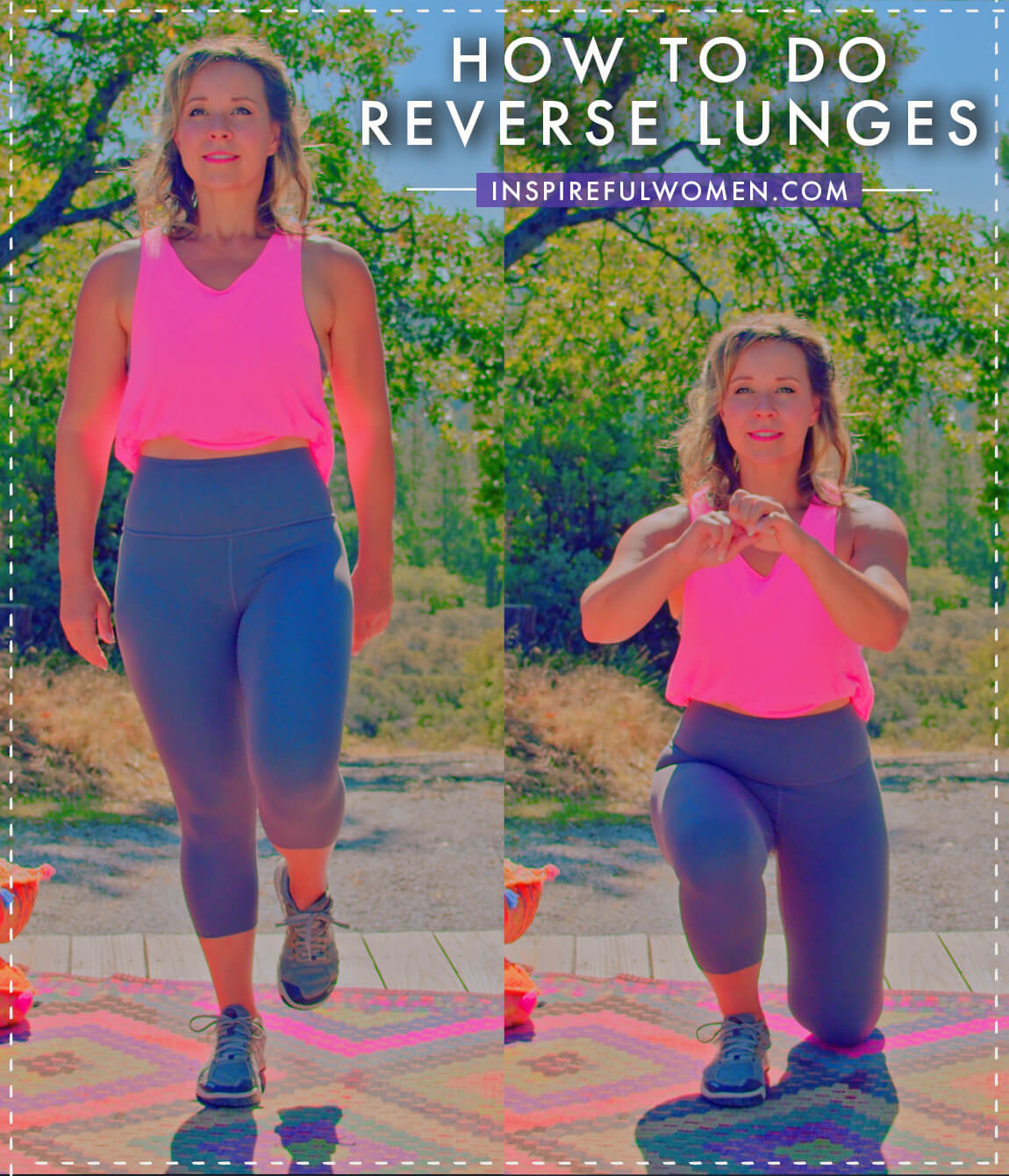
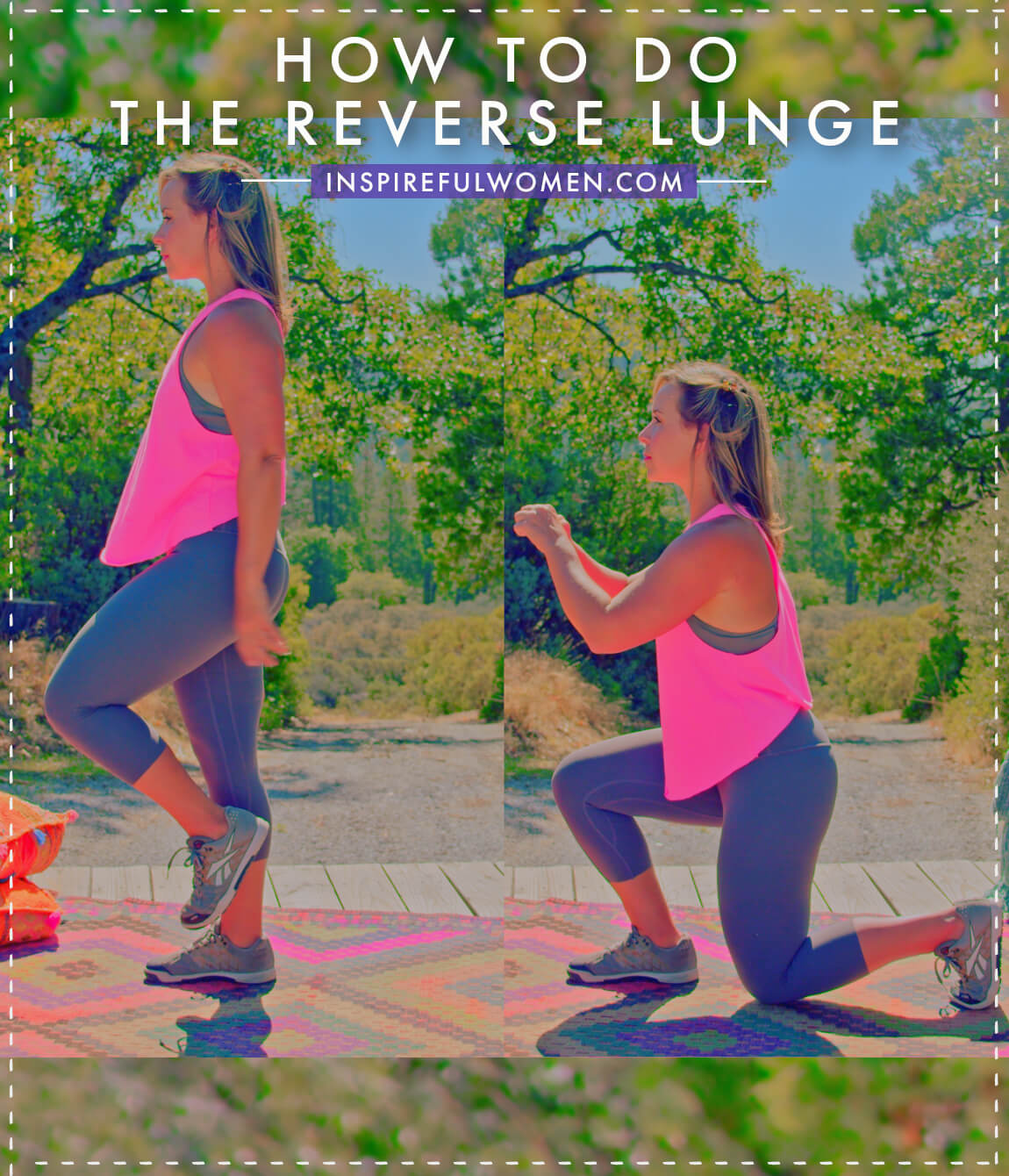
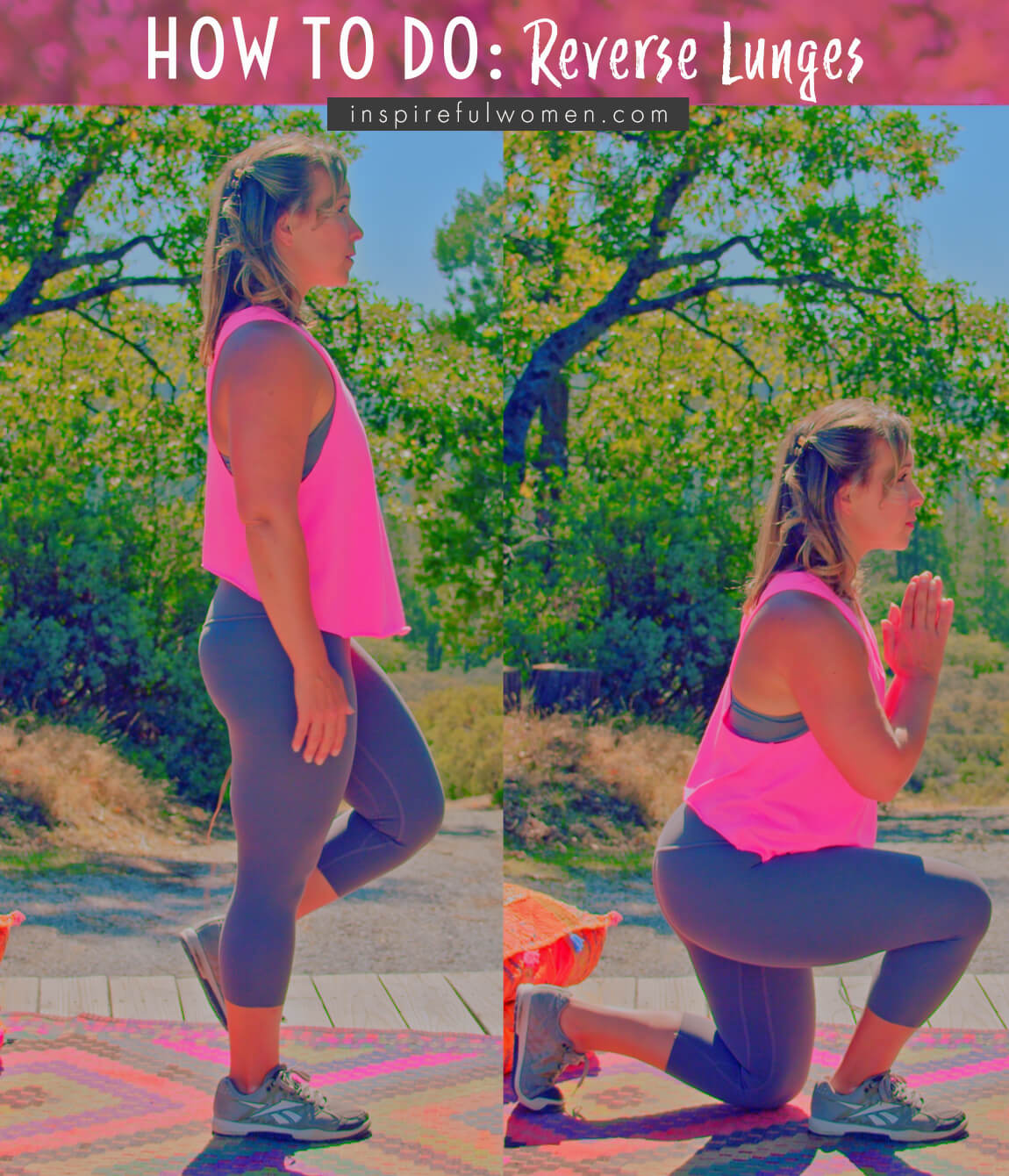
COMMON MISTAKES
COMMON MISTAKES
WHAT TO AVOID WITH THE Reverse Lunge
KEY TIP:
Guess what? Good news! Many avoids are the same for most movements. Once you learn the basics, there's really only a few extra avoids for each individual movement.
1. Avoid Pelvis Tilt
AVOID: Avoid letting the pelvis rotate or tilt.
WHY NOT?
- This is probably the most common mistake.
- This happens when you move through the pelvis and back instead of the leg - usually due to weak hip abductors.
- Rotating or dropping the pelvis will decrease muscle activation in the gluteus medius and minimis.
WHAT TO DO:
- Try the following:
- Shorten up your stance.
- Put your hands on the top of the pelvis to monitor the movement.
- Use a mirror if possible.
- Limit the depth of your lunge.
- Avoid not straightening your hip all the way to the top of the movement.
- After lunging down, when you push back up to standing, make sure to fully straighten the hip.
- There should not be a crease at the front of the hip (either one).
- This is a pretty common error, it will decrease the activity of the gluteus maximus and hamstrings.
- Slow down the movement and get a nice contraction of the hip extensors at the top of each lunge, before stepping back for the next rep.
- After lunging down, when you push back up to standing, make sure to fully straighten the hip.
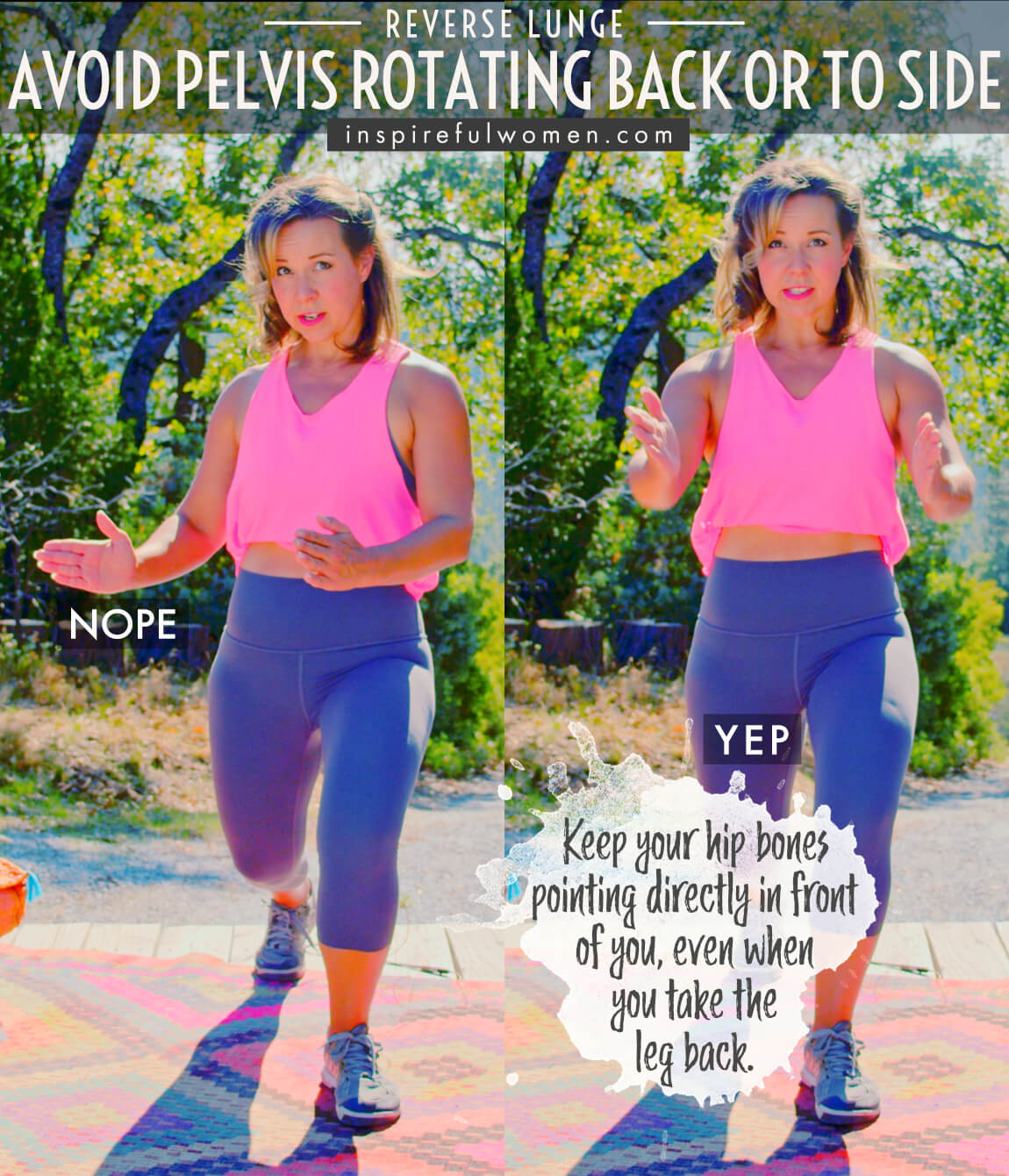
2. Avoid Knee Caving In or Out
AVOID: Avoid letting the knee collapse in or out.
WHY NOT?
- This puts too much strain on the ligaments on the sides of the knee joint.
WHAT TO DO:
- A goal of the exercise is to work the muscles and train the body to move with proper form, this includes the alignment of the leg.
- Keep the thigh in line with the knee, in line with the lower leg and ankle.
- The center of the kneecap should line up with the second and third toes (approximately).
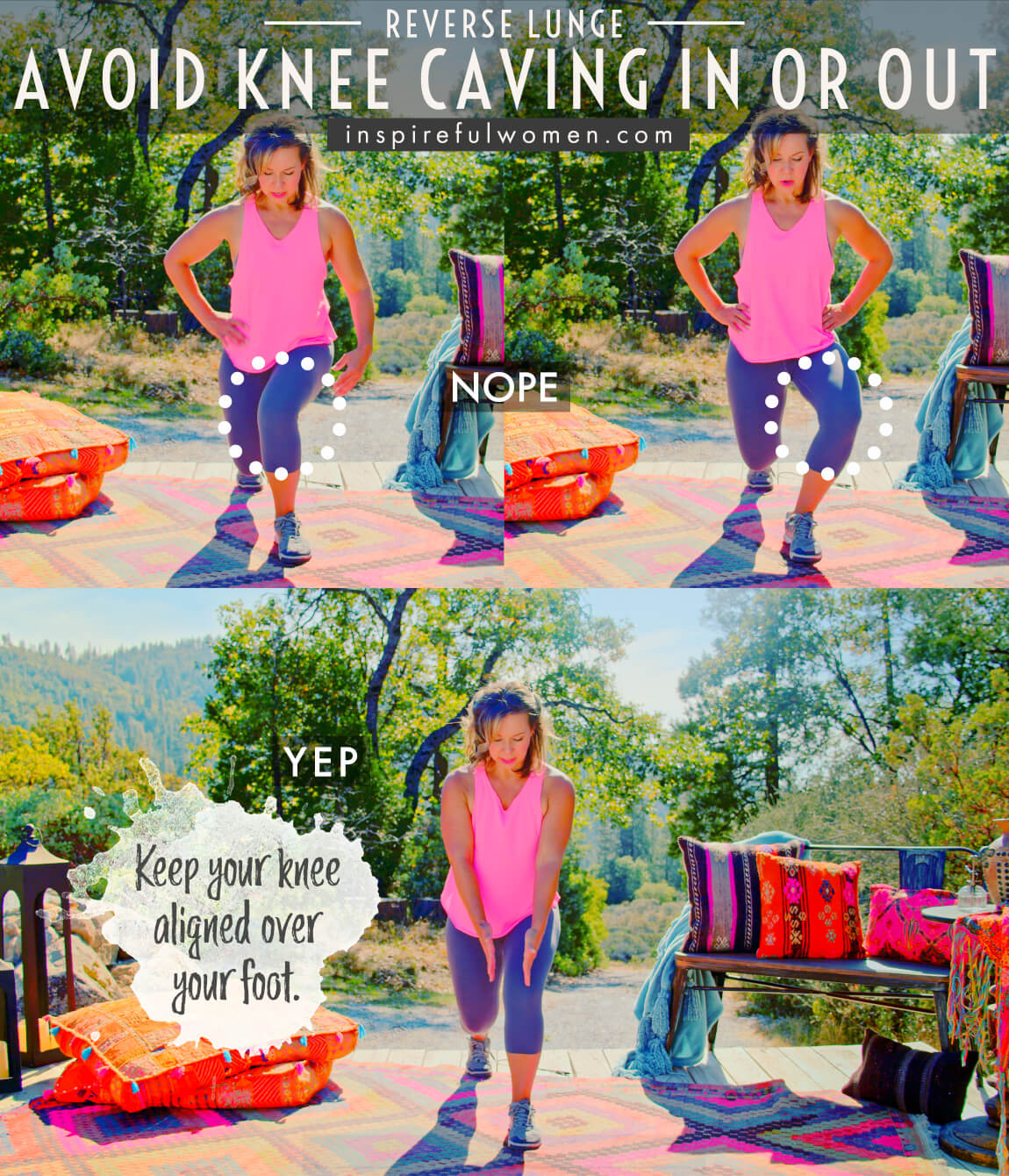
3. Avoid Hip Dropping
AVOID: Avoid hip dropping.
WHY NOT:
- When this happens (huge struggle for me!) it means that the glute medius of the WORKING leg is not doing its job and that will cause your working hip to kind of move outwards laterally, causing the other hip to drop.
WHAT TO DO:
- Try to keep your hip level as you take the leg back.

4. Avoid Keeping Hip Bent
AVOID: Avoid not straightening your hip all the way to the top of the movement.
WHY NOT:
- After lunging down, when you push back up to standing, make sure to fully straighten the hip.
- There should not be a crease at the front of the hip (either one).
- This is a pretty common error, it will decrease the activity of the gluteus maximus and hamstrings.
WHAT TO DO:
- Slow down the movement and get a nice contraction of the hip extensors at the top of each lunge, before stepping back for the next rep.
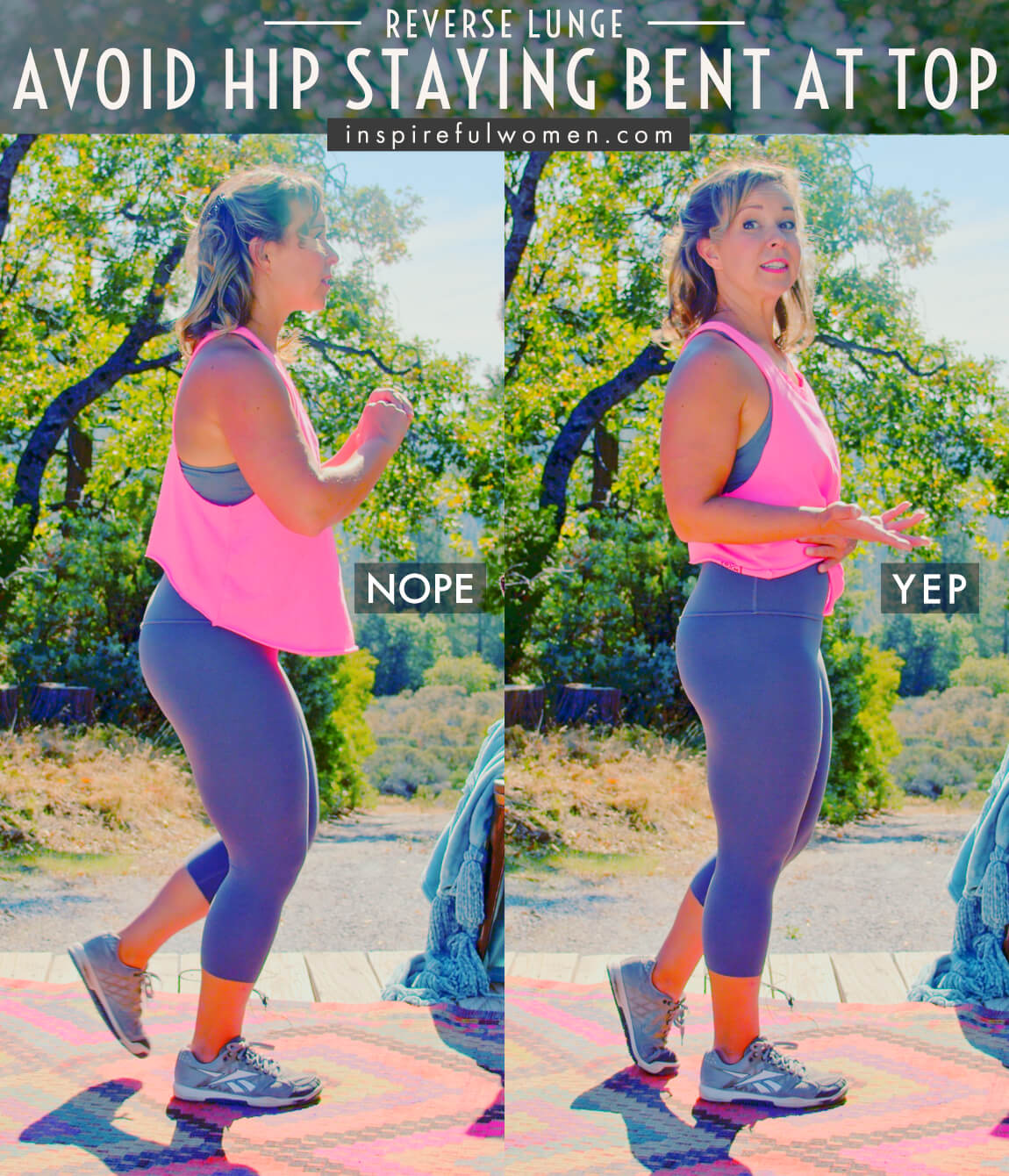
5. Avoid Wrong Weight Distribution
AVOID: Avoid keeping too much weight on your back leg.
WHY NOT?
- This will decrease the activity of the targeted muscles.
WHAT TO DO:
- Remember that this is a transition from 2 legs to single-leg exercise.
- You should feel like the front leg is doing most of the work and the back leg is just there to help when needed and keep you balanced.
- About 70-75 percent of your weight should be on the front leg.
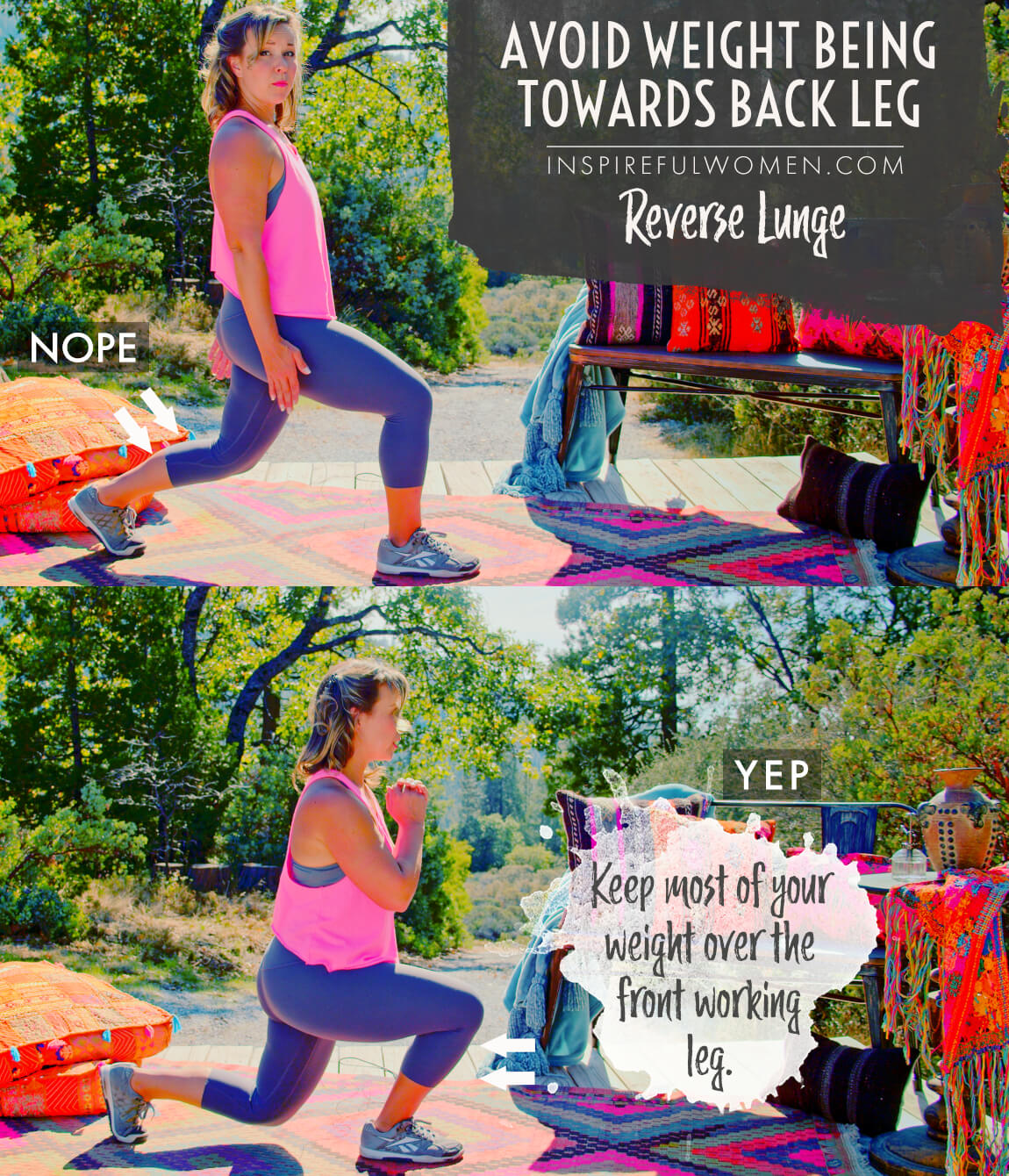
6. Avoid Heel Lifting
AVOID: Avoid lifting the heel of the front leg as you lunge down.
WHY NOT?
- This shifts your weight forward and puts too much strain on the front of the knee.
WHAT TO DO:
- Keep the weight evenly distributed on the bottom of your foot - both sides of the heel and both sides of the ball.
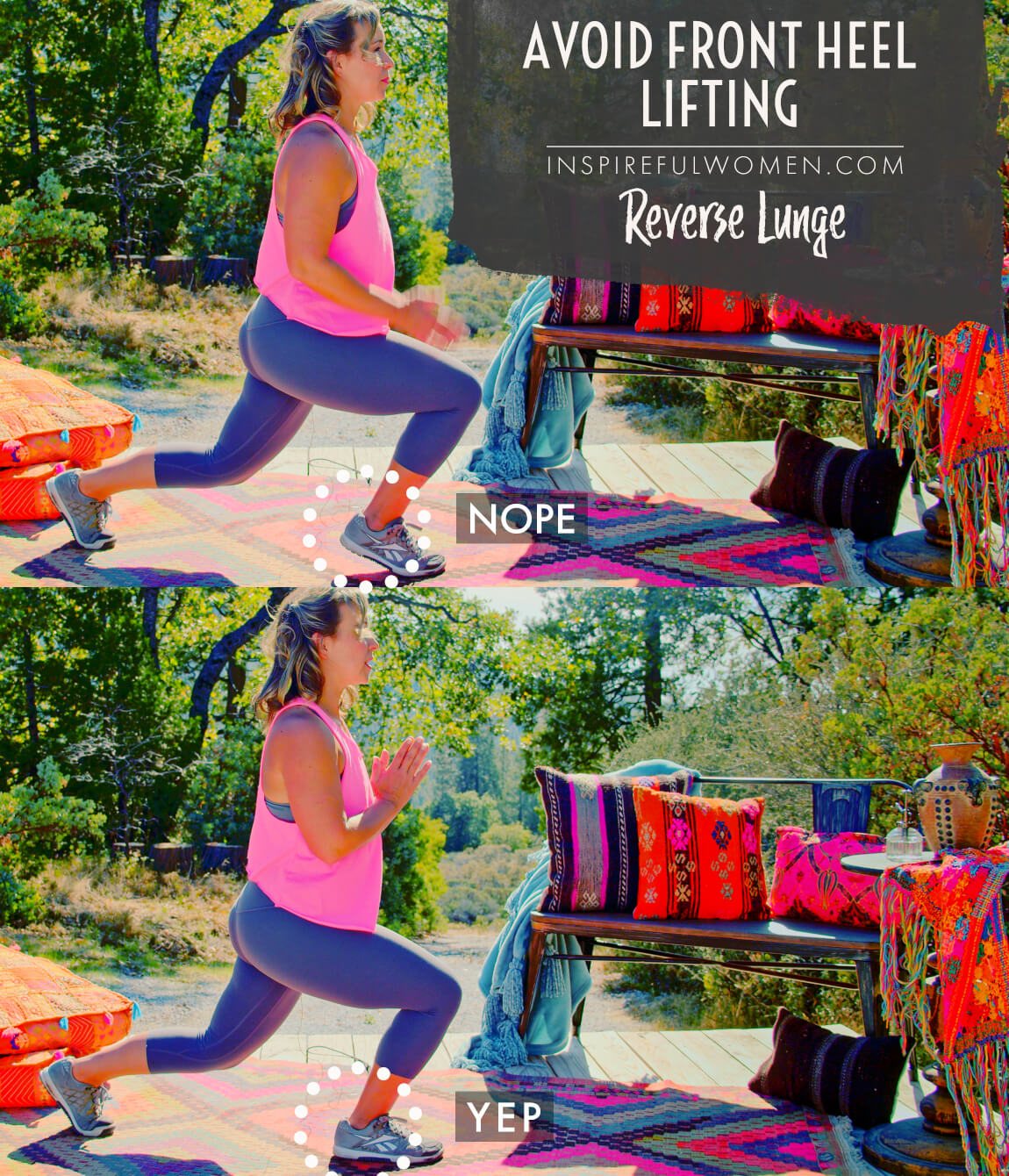
MAKE IT HARDER
HARDER
MAKING THE Reverse Lunge MORE CHALLENGING
Dumbbells Hanging From Hands
Hold Weights in Your Hands
Once you have mastered the reverse lunge - including getting the thigh parallel to the floor without knee pain, and good alignment and control, you can hold one dumbbell in each hand down by your sides.
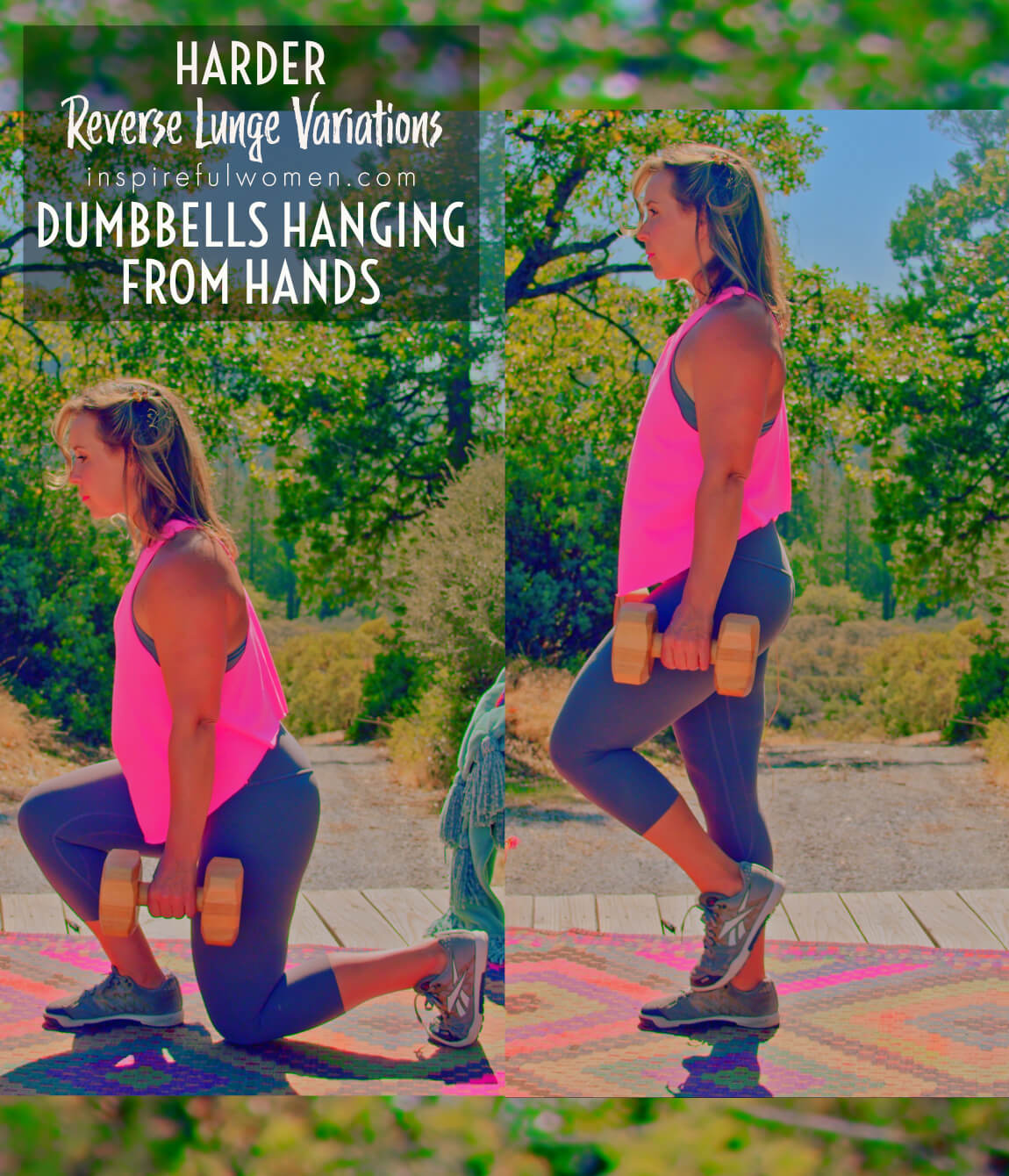
Dumbbells On Shoulders
Hold Weights on Shoulders
This increase the load on the leg muscles.

Dumbbells Against Chest
Hold Weights Against Your Chest
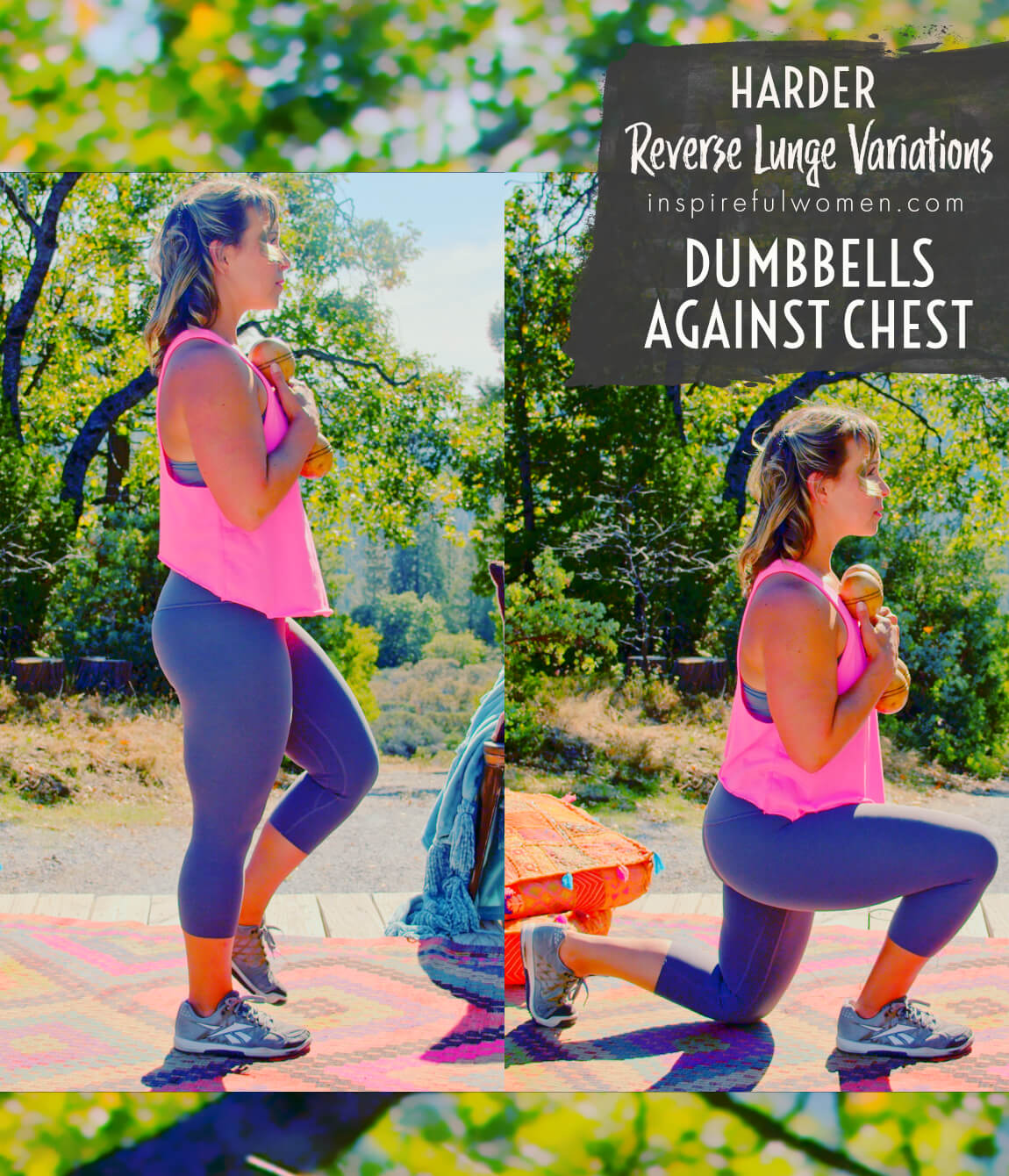
ADD ISO HOLD
Add Isometric Hold to Reverse Lunge
Hold the lunge position for 3-5 seconds. This increases the time that the muscles are under tension.
Pulse At Bottom
Add Pulses at bottom of reverse lunge
In the lunge position move up and down a few inches in each direction 3-5 times. This increases the time that the muscles are under tension.
SCIENCY STUFF
SCIENCY STUFF
SPIFFILICIOUS FACTS ABOUT MUSCLES & MOVES
The single-leg exercise uses body weight for resistance so the working leg is actually lifting nearly your body weight minus the weight of your lower leg, so for a 120# person you are squatting about 105#.
The kneecap (patella) is a small bone that actually grows in the tendon of the quadriceps (the patellar tendon). All four muscles that make up the quadriceps join together into one tendon that crosses the front of the knee and attaches on to the front of the tibia (at the tibial tubercle).
The back of the patella forms a joint with a groove in the femur. So when you bend, your kneecap moves down and when you straighten the knee the kneecap moves upwards. It slides up and down in the groove of the femur.
As the knee bends, the back of the patella moves deeper into the groove of the femur. With the forward lunge, there is a forward force through the femur - the weight of the body is moving forward all directed at the front of the knee. This can contribute to the knee strain that is sometimes felt with forward lunges.
People frequently have some arthritis on the back of their kneecaps- just normal wear and tear over time. As the kneecap rides up and down on the femur under pressure it can wear down even more. So the lunges may not hurt at all while you do them or even after you, but they can be increasing the wear and tear on the joint.
Many people tend to have tight quads, this would further increase the compression of the joint. Hinging at the hips will put some slack on the rectus femoris which can help to decrease the pressure behind the kneecap when in the lunge position.
ALLLL MUSCLES & WHEN
ALL MUSCLES WORKING & WHEN DURING THE Reverse Lunge
The core stabilizers will be active throughout the exercise to maintain a neutral spine. The hamstrings and glute max of the non-working leg contract concentrically to step back. The muscles of the front or working leg will co-contract around the ankle, knee, and hip to support the weight and stabilize the joints.
Working leg (lunging): The quadriceps work eccentrically with the gluteus maximus, hamstring, and calf muscles as the hip and knee flex and the ankle moves into dorsiflexion to lunge downward. These same muscles will contract concentrically to push the body back into upright standing. The gluteus maximus and hamstrings will contract at the top of the movement to pull the hip back into a neutral position. When the front knee and hip are straight, the back leg is brought forward by concentric contraction of the rectus femoris and iliopsoas. The back leg’s role is primarily to maintain balance and stability, it can help on the return to standing as needed.
PIN IT FOR LATER!
